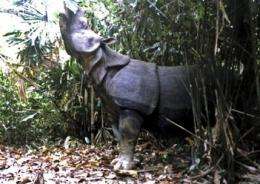Officials scramble to save endangered Javan rhinos

(AP) -- The discovery of three dead Javan rhinos has intensified efforts to save one of the world's most endangered mammals from extinction, with an electric fence being built Monday around a new sanctuary and breeding ground.
With only about 50 of the species left in the wild - all but a handful living in one national park in western Indonesia - conservationists are even talking about taking the rare step of relocating some of the 5-ton animals to spread out the population and give the Javan rhino a better chance to survive.
Drought and proximity to an active volcano in the densely forested Ujung Kulon park have raised fears that a natural disaster could destroy almost the entire population at once. In Vietnam, the only other place the rhinos can be found, there are just four.
"Without drastic action, some rhinos could be extinct in the wild within the next 10 to 20 years," the International Rhino Foundation said.
The Javan rhino, once the most widespread of Asian rhinoceroses, is today the most threatened of five species.
The species was nearly wiped out in 1883 when the Krakatau volcano erupted, spawning a 120-foot (40-meter) tsunami that killed 37,000 people when it inundated more than a hundred villages - and Ujung Kulon.
The greatest threat they face today is from poachers, habitat destruction and competition for food with other species, according to conservationists.
Rhino horns have long been a popular ingredient in traditional Chinese medicines, fetching tens of thousands of dollars each.
A prolonged dry season in western Indonesia has drained some water sources for the rhinos, and there is also a shortage of grass and other staple foods.
Conservationists have been alarmed at losing three Javan rhinos recently.
"When you are talking about populations as small as this, even one death is significant," said Adhi Rachmat Haryadi, a WWF-Indonesia official at the Ujung Kulon park.
Two skeletons have been found in recent weeks in the Indonesian park, about 160 kilometers (100 miles) southwest of the capital, Jakarta. Though an investigation is ongoing, those animals appear to have died of natural causes within the last three months, Haryadi said.
The third was the suspected victim of poachers. It was found in Vietnam in April and had been shot with its horn chopped off.
On Monday, Indonesian officials were stepping up efforts to save the few animals that remain.
They started installing a 7-mile- (12-kilometer-) long electric fence around a new 10,000-acre (4,000-hectare) sanctuary and breeding ground located alongside Ujung Kulon.
Park chief Agus Priambudi said some of the rhinos will be herded into the area after it is completed later this year.
In addition, he said conservation groups are working closely with the Indonesian government to try to find suitable areas for relocation - either on Java or neighboring Sumatra island - to help spread the species more widely.
"We need someplace that has pools and wallows," said Darori, a senior official at the Forestry Ministry, who wants the rhinos to maintain a steady growth rate of 3 percent.
It is rare to capture a glimpse of the rhino in the wild, but officials hope 58 camera traps set up in the park just over a month ago will provide some valuable information about their numbers and habits. Workers retrieved the cameras last week and planned to start reviewing the footage Monday.
Encouragingly, efforts to save the Javan rhino have met with some success in the past.
There were just about 20 left in Ujung Kulon area before the 1960s, but the World Wildlife Fund's efforts helped increase the number to 50 in the 1990s. Since then, figures have mostly remained steady.
The WWF says competition for food and space is also a problem for the rhinos, who share the (297,881-acre (120,551-hectare) Indonesian park with leopards, silvery gibbons, crab-eating macaques, mouse-deer and hundreds of bird and snake species.
©2010 The Associated Press. All rights reserved. This material may not be published, broadcast, rewritten or redistributed.



















